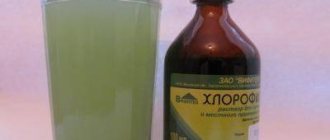Features of application
Decamethoxin in the concentration used in Decasan ® has no toxic effect. Long-term use of Decasan does not cause any toxic reactions. Warming the drug to 38 ° C before use increases the effectiveness of the action. For inflammatory phenomena and skin irritations, dilute the drug with distilled water in a ratio of 1: 1 or 1: 2.
Decasan is an antiseptic drug, which is a 0.02% solution of decamethoxin in a 0.9% sodium chloride solution in bottles.
The Yuria-Pharm company produces the drug in vials for external and intracavitary use, and for the treatment of respiratory infections there is a form of release in nebulas (sterile single-dose containers).
Antiseptics are drugs that are used to disinfect surfaces, equipment, wounds, skin and mucous membranes. Some of them have the effect of inhibiting the reproduction and growth of bacteria, others directly destroy microbes.
Decamethoxin is a surfactant. The mechanism of the antimicrobial action of decamethoxin is based on disruption of the permeability of the cell membrane, inactivation of the exotoxin and inhibition of protein synthesis of microorganisms.
- Bactericidal effect - against staphylococci, streptococci, diphtheria and Pseudomonas aeruginosa;
- fungicidal effect - against many types of fungi (aspergillus, yeast);
- highly active against microorganisms resistant to antibiotics - penicillin, chloramphenicol, tetracyclines, streptomycin, etc.
- anticystoid (Trichomonas, Giardia) and viruscidal effects.
Decamethoxin is able to reduce exudation by inhibiting the production of serotonin by cells.
A unique property of Decasan is the lack of interaction with human cells, due to which it is not absorbed from the surface of the mucous membranes, so there is no risk of systemic side effects. Does not cause irritation of mucous membranes, and consequently, local undesirable manifestations.
It should be noted that Decasan can increase the sensitivity of microorganisms to antibiotic therapy.
The drug is widely used in outpatient and clinical practice; it is effective for abscesses, carbuncles, purulent-inflammatory processes of soft tissues, bacterial and fungal skin diseases.
In addition to external use, it has been shown to be effective as an inhaled drug for pneumonia and diseases of the upper and lower respiratory tract.
The drug has a large evidence base of effectiveness and safety of use. A wide range of antimicrobial, antifungal and antiviral effects with an almost complete absence of side effects allows Decasan to be used as an antiseptic for various therapeutic and prophylactic purposes.
Release form and price range
The product is available in two forms: bottles of 100, 200 or 400 mg or nebulas of 2 mg intended for the procedure.
The release form of Dekasan nebula is convenient for use with a nebulizer. The price range varies from 50 to 200 hryvnia in Ukraine and from 100 to 350 rubles in Russia. The price depends on the volume of the solution and the form of release of the product.
The risk of overdose of the drug is eliminated, since it does not penetrate the human circulatory system.
Indications for use
Considering the wide range of applications of the drug, we should highlight first of all its use in the treatment of inflammation and other pathological processes of the respiratory system. Among the indications are:
- acute and chronic runny nose;
- sinus inflammation;
- inflammation of the tonsils;
- acute and chronic bronchitis;
- throat diseases caused by staphylococcal or streptococcal infections;
- inflammation of the larynx as an independent disease or complication after infectious diseases;
- inflammation or polycystic lung disease.
The use of the drug at the initial stage of the acute form of the disease does not allow the pathological process to develop into chronic forms.
Contraindications and possible side effects
One of the main advantages of the drug is the almost complete absence of contraindications. The only reason to discontinue the drug will be its individual intolerance by the patient.
When used, side effects such as a feeling of heat and burning in the chest area sometimes occur. These symptoms also do not require treatment and disappear quickly after stopping use of the drug.
Inhalations with Decasan: how to do and how to dilute?
Before inhaling Decasan through a nebulizer, you must carefully study the instructions that are in the package along with the drug.
It provides complete information about the features and describes the method of application.
Peculiarities
Decasan has an antimicrobial antifungal effect, concentrates on the cytoplasmic membrane (CPM) of the microbial cell and connects with phosphatidic groups of membrane lipids, disrupting the permeability of the CMP of microorganisms. Decamethoxin has a pronounced bactericidal effect on staphylococci, streptococci, diphtheria and Pseudomonas aeruginosa, capsular bacteria and a fungicidal effect on yeast, yeast-like fungi, pathogens of epidermophytosis, trichophytosis, microsporia, erythrasma, some types of mold fungi (Aspergillus, Penici), protistocidal effect on Trichomonas, Giardia, viruscidal effect on viruses. Highly active against microorganisms resistant to antibiotics. Forms resistant to decamethoxin with long-term use are formed slowly and in small quantities. Bacteriostatic (fungistatic) concentrations are similar to its bactericidal (fungicidal), virusicidal, protistocidal concentrations. During treatment, the sensitivity of antibiotic-resistant microorganisms to antibiotics increases.
Directions for use and doses
For purulent and fungal skin lesions, purulent wounds, use the solution in the form of rinses and lotions. For the treatment of proctitis and ulcerative colitis, administer a warm solution in the form of enemas of 50-100 ml 2 times a day until the signs of acute inflammation completely disappear. Fistulas with chronic paraproctitis should be washed with Decasan ® daily for 3-4 days. To wash the bladder in adult patients, use decamethoxin solution after preliminary dilution 1:7 with purified water in a dose of 500-600 ml (7-20 washes per course of treatment).
Damage to the oral mucosa is treated by applying 25-50 ml for 10-15 minutes or rinsing (100-150 ml). The dystrophic-inflammatory form of periodontal disease I-II in the acute stage is treated by irrigating pathological gum pockets with a warm solution (50-70 ml) or applying applications to the gums to attenuate inflammatory phenomena. Patients with candidiasis of the oral mucosa and ulcerative-necrotizing gingivitis should be prescribed mouth rinses (100-150 ml) 4 times a day for 5-10 days.
Treatment of candidiasis of the tonsils and chronic tonsillitis is carried out by washing the lacunae of the palatine tonsils (50-75 ml per wash).
Sanitation of carriers of staphylococcus and diphtheria bacillus is carried out by rinsing the pharynx with a solution, washing the lacunae, irrigating the nasopharynx and tonsils. Wash the lacunae 3-5 times every other day.
In adults with lung abscess, bronchiectasis, cystic hypoplasia of the lungs complicated by suppuration, chronic bronchitis in the acute phase, administer Decasan ® endobronchially:
- through a microtracheostomy 25-50 ml 1-2 times a day; through a transnasal catheter 5-10 ml 1 time per day
- by ultrasonic inhalation method, 5-10 ml 1-2 times a day;
- using lavage of the tracheobronchial tree in a volume of 100 ml.
Duration of treatment is 2-4 weeks.
When treating purulent-inflammatory diseases of the abdominal and pleural cavities, fill the affected area to the brim with Decasan ® with an exposure of at least 10 minutes. If necessary, including when suturing “tightly” (without drainage), carry out repeated filling of the operating cavity with subsequent removal of the solution to clean rinsing water. Flow-flushing drainage of the cavity is performed using drains or the puncture method.
For the treatment of microbial and fungal trichomonas lesions of the vaginal mucosa, use Decasan ® in the form of douching (50-100 ml of the drug heated to 38 ° C 3 times a day). In the same way, carry out prenatal sanitation of the birth canal once. Treatment of postpartum endometritis is carried out by washing the uterine cavity with a warm preparation (150-200 ml) 2 times a day.
Disinfection of the skin of hands and rubber gloves is carried out by applying 5-10 ml of the drug to a previously washed surface to be disinfected for 5 minutes.
Children: Disinfect cleaned medical instruments, mouthpieces, tubes and equipment by immersing them in the solution for 30 minutes.
Use for the treatment of children over 12 years of age with chronic bronchitis in the acute phase, using ultrasonic inhalation, 5-10 ml 1-2 times a day. For other indications, there is no experience of use in children under 18 years of age.
Instructions for use of Dekasan for inhalation with a nebulizer for adults and children
In the treatment of ENT diseases, external means are used to remove infection from the mucous membrane.
Antimicrobials inhibit the growth of pathogenic microorganisms and help stop inflammation.
Decasan is a substance often used by ear, nose and throat specialists for inhalation nebulizers, disinfection and destruction of pathogenic flora, effective against many microorganisms, including fungi, bacteria and viruses.
Composition and description of the drug
The basis of the drug is decamethoxin, a substance designed to destroy pathogenic microorganisms.
1 milliliter of the drug contains 0.2 milligrams of decamethoxin, as well as sodium chloride and water.
Dekasan is an antiseptic, i.e. destroys pathogenic flora on the skin and mucous membranes. The range of antimicrobial action is very wide:
- fungicidal - inhibits the activity of fungi;
- virucidal - inactivates viruses;
- simplecidal - kills protozoa;
- antibacterial - acts on gram-positive and gram-negative strains of bacteria.
decamethoxin destroys the protective properties of the cell membranes of microorganisms, reacts with the internal contents and causes cell death (lysis). The activity of the drug is very high.
Dekasan is dangerous. :
- diphtheria and synagogue sticks;
- staphylococci;
- lard;
- erythrazole;
- streptococci;
- trichomonas;
- a large group of the most common fungal pathogens - yeast-like, moldy, trichophytes, etc.
Human cell membranes and beneficial microflora do not react to decasan; the drug exhibits a high selective effect only on pathogenic substances.
Experience has shown that the drug acts on microorganisms against which many antibiotics are powerless.
Getting used to the effect of Dekasan takes a long time; the entire treatment period is equally effective. Even microorganisms that do not die are weakened and respond better to antibacterial agents, which speeds up recovery.
All medications taken remain on the surface, there is no penetration into the blood.
What are the release forms?
Dekasan is produced in the form of a transparent solution, which is packaged in containers of various sizes. Available for sale:
- bottles - 50, 100, 200, 400 milliliters.
- Soft containers - 50, 100, 250, 1000 milliliters.
- Fog (container) for sprayer - 2 milliliters.
The last form refers to inhalations with the device.
Indications for use
The treatment solution is prescribed by ear, nose and throat doctors:
- chronic forms of laryngopharyngitis;
- tonsillitis (tonsillitis);
- almond candidiasis;
- carriers of infections (staphylococci, diphtheria bacilli) - for washing;
- abscesses, phlegmons, pustular lesions.
Decasan is used to eliminate infections of many organs:
- for the treatment of skin, all types of infections and open wounds for boils, abscesses;
- for oral pathology;
- for upper respiratory tract infections, cough indicates inhalation;
- for gastrointestinal therapy;
- for surgical treatment of wounds;
- for diseases of the genitourinary area, including gynecology.
Indications
Treatment of pustular bacterial and fungal skin diseases, microbial eczema, purulent-inflammatory lesions of soft tissues (abscesses, carbuncles, phlegmons, boils, purulent wounds, panaritiums) dental diseases (stomatitis, ulcerative-necrotic gingivitis, dystrophic-inflammatory form of periodontal disease I-II degrees in the acute stage).
Also indicated for lung abscess, bronchiectasis, cystic hypoplasia of the lungs, complicated by suppuration, chronic bronchitis in the acute phase, chronic tonsillitis, tonsillitis, carriage of staphylococci and diphtheria bacilli, ulcerative colitis, paraproctitis.
In gynecological practice - for the treatment of candidiasis of the vaginal mucosa, inflammatory diseases of the genitals of microbial origin, prenatal sanitation of the birth canal, treatment of postpartum endometritis.
Purulent-inflammatory diseases of the abdominal and pleural cavities.
For hygienic disinfection of the skin of medical staff's hands and rubber gloves when examining patients and performing medical procedures and minor surgical interventions, pre-sterilization disinfection of medical instruments and diagnostic equipment made of metals, rubber, polymeric materials and glass.


